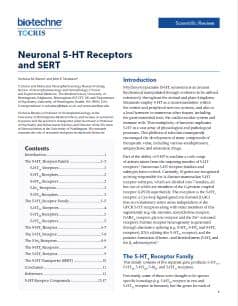5-HT2 Receptors
Serotonin 5-HT2 receptors are a subfamily of 5-HT receptors which bind the neurotransmitter serotonin (5-hydroxytryptamine). Three subtypes have been identified: 5-HT2A, 5-HT2B and 5-HT2C.
5-HT2A, 5-HT2B and 5-HT2C are are G-protein-coupled receptors that couple to Gq/11 causing activation of phospholipase C (PLC). PLC in turn hydrolyzes phosphatidylinositol (PIP2) to diacylglycerol (DAG) and inositol triphosphate (IP3).
Literature for 5-HT2 Receptors
Tocris offers the following scientific literature for 5-HT2 Receptors to showcase our products. We invite you to request* your copy today!
*Please note that Tocris will only send literature to established scientific business / institute addresses.
5-HT Receptors Scientific Review
Written by Nicholas M. Barnes and John F. Neumaier, this review summarizes the various serotonin receptor subtypes and their importance in mediating the role of serotonin in numerous physiological and pharmacological processes. Compounds available from Tocris are listed.
Depression Poster
Major depressive disorder is characterized by depressed mood and a loss of interest and/or pleasure. Updated in 2015 this poster highlights presynaptic and postsynaptic targets for the potential treatment of major depressive disorder, as well as outlining the pharmacology of currently approved antidepressant drugs.
5-HT2 Receptor Data
| Receptor Subtype | 5-HT2A | 5-HT2B | 5-HT2C |
|---|---|---|---|
| Transduction Mechanism | ↑ PLC (Gq/11) | ↑ PLC (Gq/11) | ↑ PLC (Gq/11) |
| Primary Distribution | Forebrain, caudate nucleus, nucleus accumbens, hippocampus, olfactory tubercle, vascular smooth muscle, blood platelets | Brain, stomach fundus (rat), gut, heart, kidney, lung | Choroid plexus, cortex, limbic system, basal ganglia |
| Function | Neuronal depolarization, head twitch, hyperthermia, modulation of neurotransmitter release smooth muscle contraction, platelet activation | Contraction of the stomach fundus, anxiety | Hypolocomotion, hypophagia, penile erection, hyperthermia, anxiety, ↓ noradrenalin and dopamine release |
| Selective Agonists | TCB-2 (2592) | BW 723C86 (1059) |
MK 212 (0941) Ro 60-0175 (1854) SCH 23390 (0925) WAY 161503 (1801) WAY 629 (2173) CP 809101 (3041) 1-Methylpsilocin (3017) |
| Non-subtype Selective Agonists |
PNU 22394 (2201)* α-methyl-5-hydroxytryptamine (0557) |
PNU 22394 (2201)* α-methyl-5-hydroxytryptamine (0557) m-CPP (0875) |
PNU 22394 (2201) α-methyl-5-hydroxytryptamine (0557) m-CPP (0875) |
| Selective Antagonists |
R-96544 (1742) Spiperone (0995) 4F 4PP (0523) Risperidone (2865) Altanserin (1809) |
SB 204741 (1372) LY 272015 (3077) |
N-Desmethylclozapine (1007) RS 102221 (1050) SB 242084 (2901) |
| Non-subtype Selective Antagonists |
Cyproheptadine (0996) MDL 11,939 (0870) Ritanserin (1955) |
Cyproheptadine (0996) MDL 11,939 (0870) Ritanserin (1955) |
Cyproheptadine (0996) MDL 11,939 (0870) Ritanserin (1955) |
*partial agonist
References
Hoyer et al (1994) VII. International union of pharmacology classification of receptors for 5-hydroxytryptamine (serotonin). Pharmacol. Rev. 46 157. Barnes and Sharp (1999) A review of central 5-HT receptors and their function. Neuropharmacol. 38 1083. Pauwels (2003) 5-HT receptors and their ligands. Tocris Reviews No. 25.

